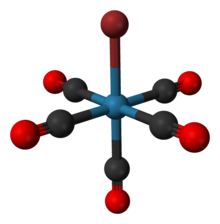
| |
| Names | |
|---|---|
| IUPAC name
Bromidopentacarbonylrhenium
| |
| Identifiers | |
3D model (JSmol)
|
|
| ECHA InfoCard | 100.034.607 |
| EC Number |
|
PubChem CID
|
|
CompTox Dashboard (EPA)
|
|
| |
| |
| Properties | |
| Re(CO)5Br | |
| Molar mass | 406.16 g/mol |
| Appearance | colorless |
| Melting point | sublimes 85-90 °C (0.2 mm Hg) |
| Solubility in chlorocarbons | soluble |
| Hazards | |
| GHS labelling: | |
 
| |
| Danger | |
| H301, H311, H315, H319, H331, H335 | |
| P261, P264, P270, P271, P280, P301+P310, P302+P352, P304+P340, P305+P351+P338, P311, P312, P321, P322, P330, P332+P313, P337+P313, P361, P362, P363, P403+P233, P405, P501 | |
Except where otherwise noted, data are given for materials in their standard state (at 25 °C [77 °F], 100 kPa).
| |
Bromopentacarbonylrhenium(I) is an inorganic compound of rhenium, commonly used for the syntheses of other rhenium complexes.
Bromopentacarbonylrhenium(I) is commercially available. It is also easily and inexpensively synthesized by the oxidation of dirhenium decacarbonyl with bromine:[1]
It was first prepared by the "reductive carbonylation" of rhenium(III) bromide:[2]
Copper(I) bromide is a byproduct.
Bromopentacarbonylrhenium(I) is a precursor to other rhenium complexes. It reacts with zinc and acetic acid to give pentacarbonylhydridorhenium (HRe(CO)5).[3]
It also reacts with tetraethylammonium bromide in diglyme to give [NEt4]2[ReBr3(CO)3)], an important precursor to compounds containing the rhenium tricarbonyl fragment.[4]
Heating bromopentacarbonylrhenium(I) in water give the triaquo complex:
This route avoids the formation of the tetraethylammonium bromide byproduct, which is often difficult to remove from reaction mixtures.[5]